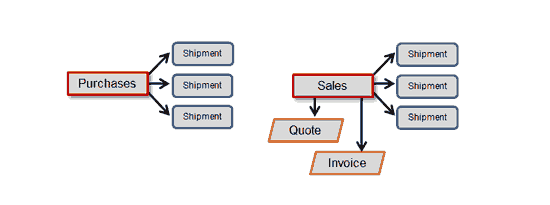Stock Control System


What Does a Stock Control System Do?
Stock control and inventory management are somewhat synonymous terms, with companies in the U.S. using the term inventory management and English-speaking countries elsewhere in the world generally using the term stock control. We use the terms interchangeably.
Stock control is how a company keeps track of its materials and products. Tracking stock items with Excel or manually with pencil and paper may suffice for small or medium-sized businesses. However, inventory control becomes more complex as the business grows. Eventually, a company organizes records and maintains consistency by adopting a stock control system.
Basic Concepts of Stock Control
Different businesses have various kinds of stock. Retailers, wholesalers and distributors keep track of products they buy and sell, while manufacturers must manage product parts or materials and the actual products.
Restaurant inventory includes the supplies and materials used to make the food. Service businesses that rent equipment to customers across multiple locations must keep tabs on these items. While inventory varies, the primary stock control concepts and processes remain the same across industries and companies.


First, suppliers purchase required items, which become company inventory. Then, the company assembles parts and products, transfers stock and processes work orders before selling to customers. While stock varies depending on the type of business, inventory management concepts remain consistent across all industries.
Intermediate Concepts of Stock Control
The intermediate stock control concepts cover more complicated situations. Effective stock control is crucial for preventing problems and complexities that may arise. For example, multiple shipments may contain items customers purchased, or shipments could be missing goods. You can help manage unexpected situations by separating shipments from sales.
Small and medium-sized businesses often have separate inventory management and accounting systems. Customer purchases connect the accounting and stock control departments for companies that manage their bookkeeping with QuickBooks or Excel. Quotes and invoices demonstrate which files your inventory and accounting systems can transfer between one another.


The concept of stock levels may seem simple at first, as they reflect item quantity. However, they can sometimes be slightly more complicated in real-life business operations. Different warehouses house one company’s stock, and these facilities have multiple bays, aisles or bins. Recording stock levels in practice requires tracking quantities of items across different locations.


Many companies also track stock packing. Sometimes, you’ll have to stay on top of the quantities of a specific product’s lot. Products with expiration dates or specific serial numbers can help identify stock amounts of individual lots or batches.
Detailed Concepts of Stock Control
Stock control becomes more complex at the final level of evaluation. Companies have to handle factors like discounts, working with tax authorities, multiple addresses and other similar concepts. Each level of detail integrates into the others and helps you navigate a stock control system by focusing on which elements are most relevant and essential to your business.
Types of Inventory Control
Since various industries have different kinds of inventory, some companies should use multiple stock control systems. For example, while a smaller stock company might take advantage of periodic and manual inventory control systems, larger businesses should move to perpetual and automatic inventory control systems.
What is an inventory control system? Some examples include the following.
- Periodic: Periodic inventory control systems involve counting stock weekly, monthly, quarterly or annually. However, the quantities are less reliable. Routine inventory counting is straightforward, measuring stock at regular intervals. They require little upfront costs and less technology than other methods. However, periodic counting is better for smaller operations, as larger companies must process thousands of inventory items every day. Regular counting is also more time-consuming and expensive. More frequent counts suggest that a company should progress to perpetual inventory systems.
- Perpetual: Perpetual inventory, also called cycle counting, uses in-time inventory management to show stock levels and locations. Stock gets counted every day to identify inventory trends and changes by using technology. Automated perpetual inventory management methods are more reliable and cut back on costs.
- ABC counting: This inventory control method is a way to classify inventory based on importance. The ABC method cuts costs by only counting inventory when necessary. “A” inventory, which is about 20% of items, is the highest-priority stock, and gets counted weekly or every other week. “B” stock gets counted monthly and accounts for the middle 60% of inventory. Finally, C inventory accounts for the bottom 20% of inventory, and might consist of seasonal or custom items.
- Just-in-time inventory: Just-in-time inventory happens with careful planning and alignment of every step of the supply chain. Stock is available as soon as customers place an order. While this method saves on inventory, it can be so efficient that shelves might be bare, making customers assume doors are closing.
- Barcode systems: Companies can use barcode scanners and techniques with perpetual and periodic scanning to immediately scan and update inventory data. Barcode systems are efficient and help reduce human error.
Importance of Inventory Control Systems
Inventory control systems help manage the complexity of stock so you can focus on other aspects of your business. Stock controlling systems are valuable for reasons like these.
- Real-time inventory levels and locations: Inventory control systems provide real-time inventory level and location updates to predict when you need to reorder. Knowing inventory levels prevents over or under-stocking.
- Optimized workflow: Automating inventory updates saves your company time and money by eliminating manual labor. You can integrate all marketplaces, identify bottlenecks in your workflow and easily modify inventory. Optimizing the supply chain for maximum efficiency will ultimately cut costs, increase productivity and improve the customer experience.
- Reduced inaccuracies: Automation eliminates human error, proving to be more accurate than manual labor.
- Improved customer experience: Your company will create stronger customer relationships through accurate stock analysis, as inventory updates can prevent backorders. Further, you’ll be able to fulfill more same-day or next-day deliveries if your stock levels are correct. You’ll increase customer trust with updated stock levels, as your website will accurately display inventory levels.
Barcode Systems as Part of a Comprehensive Stock Control System
For a stock control system, it bears mentioning that barcode systems are often ideal for tasks that require counting large numbers of physical items such as stock takes, receiving shipments, packing orders and shipping or transporting orders. Barcode systems provide a method of labeling and identifying products to count them quickly with a minimum chance of human error.
Most small and medium-sized companies start keeping track of their stock with stock control software before incorporating barcodes and barcode scanners. If the goals of your business systems are to reduce human error and increase efficiency, the best practice is to begin by identifying the process points that are in most need of improvement.
If the pressing problems revolve around the physical counting processes, early investment in a barcode system makes sense. If records are inconsistent or wrong, tracing back more to the organization than to miscounts, it may make sense to start with stock control software and incorporate barcoding when you have a firmer grasp of the benefits.
Examples From Finale Inventory
Watch the following example videos of using Finale to learn more about how cloud inventory management handles lot tracking and how Finale can work with your company.
Overview (simple example)
https://youtu.be/sYNDdRdZdO4
Importing a product list from Excel
https://youtu.be/gbmFO0h5nfA
Creating large sales orders (quickly)
https://youtu.be/yxvo_PyBcF8
Benefits of Stock Control System With Finale Inventory
Finale Inventory’s cloud-based inventory management software will save your organization time and money by centralizing stock management. You can see real-time inventory updates from anywhere and any device with an internet connection. Our full integration barcode scanners will help you quickly organize and label items, and we even offer barcode label generation. Our systems are also scalable to grow with your business, preventing costly IT and software upgrades.
We offer world-class customer service, with each new account assigned to a dedicated customer relationship manager who provides personalized advice and training and handles account customization. Plus, our plans are month-to-month, with no long-term commitments.
Contact Finale Inventory, schedule a demo or start your free two-week trial today to learn more about how our solutions can streamline stock management for your company!




